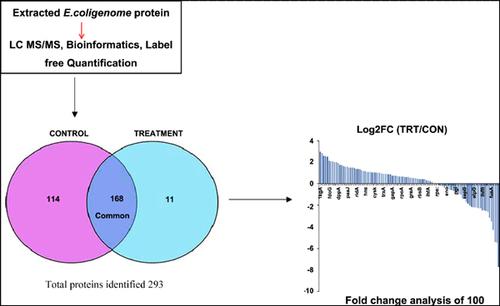Current Proteomics ( IF 0.5 ) Pub Date : 2020-09-30 , DOI: 10.2174/1570164617666191204125202 Nafeesa Khatoon 1 , Hammad Alam 1 , Meryam Sardar 2

|
Background: Silver nanoparticles pose high antibacterial properties against multi drugresistant and non-resistant bacteria. However, bacteria acquire resistance against chemically synthesized silver nanoparticles after repeated exposure. Therefore, there is an inevitable need to understand the mechanistic behavior of silver nanoparticles.
Objective: In this study, we have performed a complete proteomic analysis of Escherichia coli after the treatment with silver nanoparticles to find out the mechanism of bactericidal action of silver nanoparticles (AgNPs).
Methods: Silver nanoparticles were synthesized using Artemisia annua leaf extract and incubated with Escherichia coli to elucidate the antibacterial assay by determining MIC and the effect on the growth pattern. Further total genome proteins were isolated from control and silver nanoparticles treated bacteria, which were identified by LC MS and Label free quantification analysis technique.
Results: Total identified proteins were 293, out of which 11 proteins were exclusively present in treated bacteria; these are the proteins mainly expressed in stress conditions. Fold change analysis shows that 65 proteins were upregulated where stress proteins are overexpressed while membrane proteins were downregulated.
Conclusion: This study reveals that silver nanoparticles inhibit the expression of cellular proteins and cause cell death. Such a study may be helpful in designing drugs against resistant microbes.
中文翻译:

纳米银处理的大肠杆菌蛋白质组学分析:杀菌作用的一种分析方法。
背景:银纳米颗粒对多种耐药菌和非耐药菌具有很高的抗菌性能。然而,细菌在反复暴露后获得了对化学合成的银纳米颗粒的抗性。因此,不可避免地需要了解银纳米颗粒的机械行为。
目的:在这项研究中,我们对银纳米颗粒处理后的大肠杆菌进行了完整的蛋白质组学分析,以了解银纳米颗粒(AgNPs)的杀菌作用机理。
方法:用青蒿叶提取物合成银纳米颗粒,并与大肠杆菌一起孵育,通过测定MIC和对生长模式的影响来阐明抗菌测定。从对照和银纳米颗粒处理过的细菌中进一步分离出总基因组蛋白,通过LC MS和无标记定量分析技术对其进行鉴定。
结果:鉴定出的蛋白质总数为293,其中11种蛋白质仅存在于经处理的细菌中。这些是主要在压力条件下表达的蛋白质。倍数变化分析显示65个蛋白上调,其中应力蛋白过表达,而膜蛋白下调。
结论:这项研究表明银纳米颗粒抑制细胞蛋白的表达并引起细胞死亡。这样的研究可能有助于设计抗药性的药物。











































 京公网安备 11010802027423号
京公网安备 11010802027423号